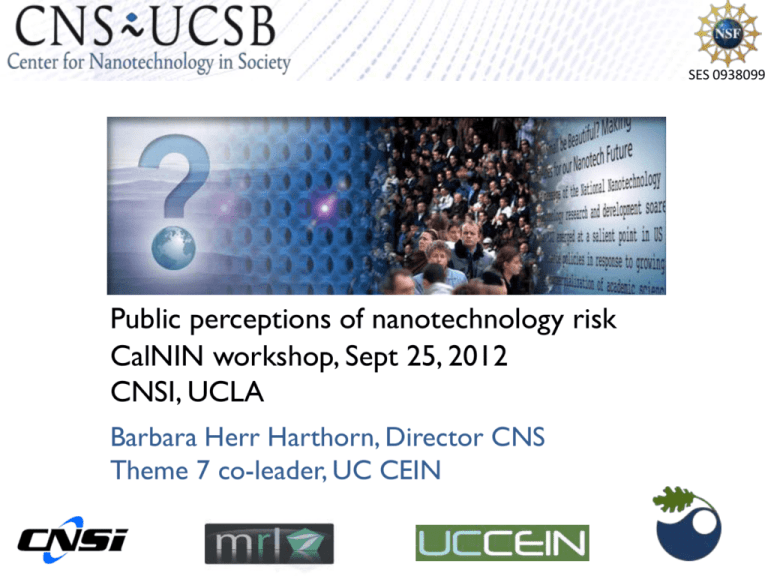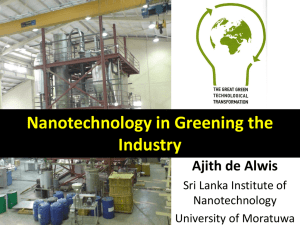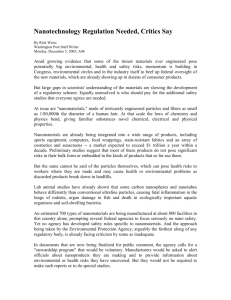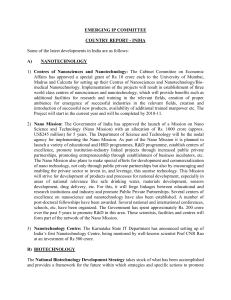Public Perceptions of Nanotechnology Risk
advertisement

SES 0938099 Public perceptions of nanotechnology risk CalNIN workshop, Sept 25, 2012 CNSI, UCLA Barbara Herr Harthorn, Director CNS Theme 7 co-leader, UC CEIN US National Nanotechnology Initiative, 2011 ELSI (ethical, legal, and societal implications) considerations “are deeply embedded in the NNI’s commitment to responsible development of nanotechnology.” “The NNI seeks to generate ELSI knowledge and insights through: (1) research in the areas of public perception and understanding expected benefits, anticipated risks, and safety that can help society assess potential impacts of nanotechnology and possible responses; (2) scientific meetings and workshops at the local, state, national and international levels; and (3) public engagement activities to identify stakeholder perspectives on nanoEHS and ELSI issues.” NNI Environmental, Health, and Safety Research Strategy, 2011: 10 SES 0938099 Mission: Nanotechnology Origins, Innovations, and Perceptions in a Global Society CNS-UCSB challenge: How can nanotechnology mature into a transformative technology, in our rapidly changing international economic, political & cultural environment? • Social and environmental sustainability, ‘responsible development’ • Requires many methods, new approaches • Demonstrate value to the S&T enterprise of understanding and engaging with social issues Key factors we focus on: • Global nano-enterprise (E. Asia, N. Europe, & Latin America focus) • Multiple party risk perception • Modes of dialogue with the public • Historical contexts for S&T development NSF: DBI-0830117 Theme 7: Societal Implications, Risk Perception and Outreach Faculty investigators: Hilary Godwin, UCLA Barbara Harthorn, UCSB J.R. DeShazo, UCLA Patricia Holden, UCSB Milind Kandlikar, UBC Arturo Keller, UCSB Timothy Malloy, UCLA Andre Nel, UCLA Terre Satterfield, UBC Many reasons for studying nano risk (and benefit) perception • Perceptions drive behavior best indicator of anticipated behavior • Not just ignorance or misunderstanding • Expert risk assessment (nanotox) won’t necessarily change views • Experts’ judgments affect their decisions and practices • Anticipate workers’ views • Anticipate communities’ views • Anticipate points of convergence/divergence among different stakeholders • Vital knowledge project of engagement and two-way/multi-way communication SES 0938099 Formal vs. lay understandings of ‘risk’ Engineering ‘Risk’ = Hazard x Exposure Lay beliefs are based on more than probabilistic ‘risk’ • Qualitative risk characteristics • Cultural or political values • Social amplification (and attenuation) effects, esp. process through which risk communication takes place • Trust in risk managers / science • Past experiences of vulnerability and discrimination • Perceived benefits also matter! What factors make novel technological risks seem less acceptable? Involuntariness Inequitable (distribution of risks and benefits) Inescapable / many exposed Unfamiliar / novel Man-made vs ‘natural’ Irreversible Invisible Danger to children Particular ‘dreaded’ outcomes (e.g. cancer) Victims identifiable Appears poorly understood by science Violates ‘dose makes the poison’ Slovic, P. et al. In Slovic, P (2000) The Perception of Risk. London: Earthscan Awareness of nanotechnology is low: ~ half know ‘nothing at all’ Satterfield, Kandlikar et al., Nature Nanotechnology, 2009 Judgment of Nanotechnology Risks and Benefits: Benefit-centric & high levels of uncertainty Satterfield, Kandlikar et al, Nature Nanotechnology, 2009 Scientists are more optimistic than the public about potential benefits Scientists are less concerned about risks other than environment & health Scheufele et al. 2007 Nature Nano Willing to purchase? Interaction of US public nanotech benefit & risk perceptions Currall & Lane 2006 Distribution of Perceptions for Different Nanotechnology Applications – Switzerland (Source: Siegrist et al, 2007, Risk Analysis, v27, 59-70, n=375 Switzerland) What has the media had to say about nano? Public Perception of ENM Environmental Risk: Shaped by Risk Messages & Environmental Values Green line: Air, water and soil recover easily, are self-cleaning, mostly pure, and easy to control. Red line: Air, water and soil recover poorly, need human intervention to become clean, are mostly contaminated and difficult to control. • • • Stated risk level affects acceptability Perceived environmental ‘resilience’affects acceptability Risk uncertaintyreluctant to judge Satterfield, Pitts, & Harthorn 2012 In preparation People get sick from a nanoproduct but it is still sold Trust asymmetry: Easy to lose, difficult to recover A study on nanoparticle safety is found to rest on fake data Industries refuse to voluntarily report nanoparticle toxicity Government declares no need for nano safety regulations A company is fined for failure to register nano-products Voluntary program established for industry to submit sci. data about nano products An environmental group calls for a complete ban on selling nano products Program established to provide consumer health guidelines for nano products Satterfield et al. in press 2012 Science& Public Policy Industry mostly complies with new regulations to register nano products Indep. consumer watchdogs will investigate public complaints ag. nanotech co.s Decrease trust Increase trust Industry is crucial part of picture US ENM industry survey (n=45, 20% response rate) • Only 44% have nano-specific EH&S program • 41% monitor the workplace • Impediments to having a nano EH&S program? 60% 50% 40% 30% 20% 10% 0% 56% 48% 31% Lack of information Lack of guidance or regulation Budget constraints Engeman et al 2012 under review Industry is a crucial part of the responsible development picture. (US survey, n=45 ENM companies, level of agreement with eleven statements re: risk & regulation. It is reasonable to assume that industries working with nanomaterials will adapt or alter their safe-handling practices when new hazards are discovered. Workplace safety should take priority over scientific and technological advances. In the case of nanotechnologies, the benefits of advancements in science and technology outweigh the risks involved in research, development, and production. Businesses are better informed about their own workplace safety needs than are government agencies. Employees are ultimately responsible for their own safety at work. Industries working with nanomaterials can be trusted to regulate the safehandling of these materials. Waiting until safety studies are complete to commercialize nanotechnology will deprive society of too many potential benefits. In my company, we worry that nanotechnologies may encounter unwarranted public backlash such as that which accompanied genetically modified foods in Europe. Voluntary reporting approaches for risk management are effective for protecting human health and the environment. Insurers in my industry are increasingly concerned about nano-specific risks. Direct involvement of citizens in policy decisions about research and development of new technologies is beneficial. Strongly agree Agree Don’t know Disagree Strongly disagree 0% 20% 40% 60% 80% 100% In summary Benefits predominate thus far—what will constrain (other than EHS)? Views are contingent on: • Publics’ low familiarity/unformed views • High uncertainty/need for information (from trusted source) • Application-specific views • Media coverage low & mixed message • Hyping the technology (benefit only information) betrayal effect • Trust/betrayal (by govt and/or industry; scientists have public trust) • Inequality/social justice key • Environmental resilience; intuitive toxicology • Gender, race, social differences: not a function of ignorance * Not just a matter of educating re: benefits, rather we need to understand and accept legitimacy of situated preferences new collaborative models * UC CEIN key such context for collaboration Thank you. Many people to acknowledge: Faculty researchers: , Bruce Bimber, Joseph Conti, Trish Holden, Milind Kandlikar, Nick Pidgeon, Terre Satterfield, ; postdocs: Gwen D’Arcangelis, Anton Pitts; grads Christian Beaudrie, Mary Collins, Shannon Hanna, David Weaver. This work is funded by NSF through cooperative agreements # SES 0531184 and #0938099 to the Center for Nanotechnology in Society at UCSB; and by NSF & EPA through cooperative agreement #DBI 0830117 to the UC Center for Environmental Implications of Nanotechnology. Views expressed here are those of the author(s) and do not necessarily reflect the views of the NSF or EPA. Novel Tool Development: California in the Nano Economy Website SES 0938099 SES 0531184 Nano Value Chain Model/Database Tables 1. Physical Location Information – Address, City, Postal Code, Phone Number, Latitude/Longitude, & Website(s) 2. General Information – Firm/Support, Year Established, Employment, Ownership, Sales, Nano-Specific Focus 3. Products – Nanomaterials & Products Incorporating Nanomaterials and Equipment – Materials & Tools Used 4. Relationships – Customers, Suppliers, Competitors – Firm Structure: Parent Companies/Subsidiaries, Investors – Product Development & Research 5. Value Chain Model – Value Chain Position: Category, Sector, Subsector, Materials – Supporting Environment – Value-Adding Activities: R&D, Design, Manufacturing, Distribution, Marketing, Service 6. Industry Sectors – Previous Information & Removed Locations – Previous Physical Address Information – Locations & Products Removed & Reason Parts of the Nano Value Chain Model Value Chain Nanoscale Materials Intermediary Products Carbon Nanotubes Nanoscale Intermediates Coatings & Ink Catalysts Metal Nanoparticles Compound Nanoparticles Nano-Enabled Final Product Industries Sporting Goods Plastic Materials Fullerenes Quantum Dots Component Products Composites Chemicals Sensors Precursor Products Circuits Energy Generation/Storage Displays & Memory Apparel & Home Goods Textiles Tires Processors Transportation Construction/Industrial Consumer Goods: NonElectronic Electronics & Energy Electronics Polymeric Materials Therapeutic Agents Personal Care Other Nanoscale Materials Drug Carriers Pharmaceuticals Medical/Life Science/Health Industry Sectors Tools, Equipment, Software, & Machinery Production Equipment Government & Academia Laboratories & Testing Facilities Analytical Tools Modeling Research Organizations Industry Associations Supporting Environment Investors Service Providers SES 0938099 SES 0531184 Visual Mapping: Tableau Occurrences




